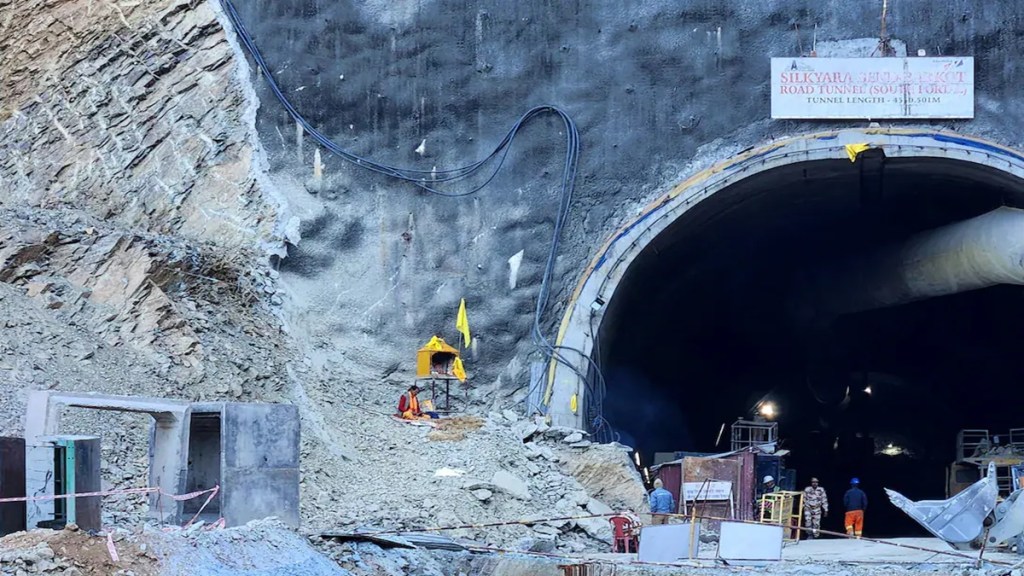At least 41 workers trapped in an Uttarakhand tunnel, after a portion of it collapsed, for over 10 days could either be pulled out within the next two days with the help of a drilling machine, but if it doesn’t work out the rescue could even stretch to as much as 15 days.
The workers have been stuck in the 4.5-km under-construction tunnel in Uttarakhand since it caved in early on November 12. They are being supplied food, water, and medicines through steel pipes.
Road Transport and Highways secretary Anurag Jain said that the American-made Auger drilling machine, which is already in action, is the best option right now and workers could be out within 2.5 days. The auger machine had come across a hard boulder on Friday afternoon, triggering vibrations that forced rescuers to put the operation on hold due to safety concerns, NDTV reported.
Also Read: First visuals of workers trapped in Uttarkashi tunnel emerge after 10 days | Video
Jain, however, added that they have kept five other action plans ready, but those could take as long as 12-15 days.
“We are working on all options simultaneously instead of waiting for one option to click. Auger and horizontal boring to create an opening parallel to the tunnel. Creating a horizontal opening could take 12-15 days,” he said.
Drilling resumes
Rescue operations have entered a critical phase as efforts to save 41 workers trapped in the Silkyara tunnel collapse in Uttarakhand’s Uttarkashi entered into the eleventh day. Drilling work resumed late on Tuesday after a pause since November 17.
The rescuers have created space for a vertical drilling platform by cutting into the mountain above the tunnel. Additionally, plans are underway to construct a micro tunnel perpendicular to the existing tunnel from the left side of the tunnel mouth, although this process is expected to take considerable time.
Also Read: Uttarakhand tunnel collapse: Wider pipeline laid to send more food, medicines to trapped workers
Horizontal drilling through the debris was put on hold last Friday afternoon after the heavy duty auger machine encountered a hard boulder, making rescue agencies consider other approaches as well.
International tunnelling expert Arnold Dix, who is at the site, said vertical drilling demanded precision. While drilling from the top, even a small mistake could mean missing the tunnel, he said. The horizontal drilling option involves inserting sections of a steel pipe as the machine drills through. The workers can then crawl out of the pipeline.
The “second-best” option involves drilling more than 80 metres vertically from above the tunnel to reach the two-kilometre built-up stretch where the workers are now confined. Drilling from the tunnel’s Balkot end is another alternative on which the rescue agencies are working. Drilling parallel tunnels is also being considered. Some of the heavy machinery for these new approaches has reached the disaster site.
Trapped men served veg pulao
The trapped labourers received a hot meal last night consisting of veg pulao, matar-paneer, and chapatis with butter, all prepared under medical supervision to ensure easy digestion. The food was delivered through a 6-inch wide pipeline that has also been used to send fruits and establish communication with the trapped workers.
Also Read: Uttarakhand tunnel collapse: What is new 5-point action plan to rescue 41 trapped workers?
For the first time in days, images of the trapped workers were captured using an endoscopic flexi camera inserted through the pipeline, providing some relief as they showed the men in good condition. Modern drilling machinery from various parts of the country has been brought to the site to support all types of drilling operations necessary for the rescue.
Uttarakhand Chief Minister Pushkar Singh Dhami has stated that the priority remains the safe evacuation of all workers and that Prime Minister Narendra Modi is being updated regularly on the progress of the rescue efforts. The National Disaster Management Authority (NDMA) has confirmed that there is sufficient water, oxygen, power, and light inside the tunnel where the workers are trapped.
(With inputs from agencies)

